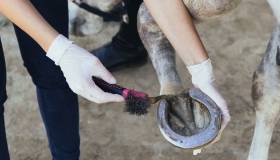
Updated September 14, 2023 – Stem cells demonstrate remarkable promise in treating a wide range of equine conditions, spanning from orthopedic injuries to organ regeneration. Yet, there remain numerous unanswered questions in harnessing the full potential of these biological marvels. What are the optimal methods for harvesting and culturing equine stem cells? Which diseases stand to benefit most from stem-cell therapy?
Equine Veterinarians Were Early Adopters
Some of the earliest uses of stem cells in veterinary medicine took place in horses. For twenty years, veterinarians have used stem cells to treat a variety of orthopedic problems in horses, including tendonitis, osteoarthritis and bone fracture repair.
While clinicians emphasize the need for further studies, there is a prevailing consensus among equine veterinarians that stem cells offer notable benefits in addressing orthopedic issues in horses. Nevertheless, there remains a multitude of unanswered questions regarding the application of stem cells in equine medicine.
What Are Stem Cells?
Before we dive deeper into how stem cells are used to treat diseases in horses, we need to take a step back and learn some basics about these remarkable cells and sort out some terminology.
Stem cells possess the remarkable capability to differentiate into any type of cell within the body, showcasing the extraordinary potential of this field! Broadly speaking, stem cells are classified into two major categories (although the terminology can be a tad perplexing):
- Pluripotent stem cells
- Adult stem cells
Pluripotent stem cells can further be divided into embryonic and induced pluripotent stem cells. As their name implies, embryonic stem cells are found at a certain stage in development and can form any type of bodily tissue, and their use can be controversial.
In 2006, scientists discovered a way to reprogram some types of adult stem cells into reverting to cells that are more like embryonic stem cells. These cells are iSPCs.
Adult stem cells tend to be found in specific organs and are like spare parts in your garage. They can help repair damage to the organ in which they're found. Unlike pluripotent stem cells, these cells can't differentiate into any cell in the body – just the ones found in the tissues where they are located. Sometimes the terms "somatic" and "non-embryonic" are used to describe these cells.
Adult mesenchymal stem cells are the most common type used in veterinary medicine.
These cells have the ability to transform themselves into many different tissue types, such as heart cells, nerve cells and blood cells. Adult mesenchymal stem cells can be harvested from a variety of tissues, but in horses they are harvested primarily from fat tissue or bone marrow. Bone marrow is typically harvested from the sternum or the hip. Fat cells most commonly are harvested from the tail head region.
The harvested cells are sent to specialized laboratories that take the tissue, isolate the stem cells, and place them in culture media. Once the cells have multiplied several times, they are collected and given back to the patient from whom they were harvested.
How Are Stem Cells Used?
While scientists are constantly discovering new uses for stem cells, the mechanics of how stem cells actually work is not completely understood. However, stem cells are commonly used to treat three main conditions in horses:
- Tendon injuries
- Ligament injuries
- Osteoarthritis and other joint diseases
Stem cells are usually used not as a sole treatment but in combination with other therapies familiar to horse owners, and anyone who has suffered some type of soft tissue or bone injury, such as physical therapy, icing and specialized bandaging.
An exciting paper published in 2022 showed a dramatic return to racing when bone marrow-derived stem-cell treatment was used in racehorses suffering from superficial tendon injury compared to those who received conventional therapy.
Lastly, there are reports of the effectiveness of stem cells in the treatment of diseases outside the musculoskeletal system such as insulin resistance and obesity but more work needs to be done to verify these findings.
Foundation Funds Cutting-Edge Stem Cell Research
Since 2008, Morris Animal Foundation has invested more than $1.3 million in research focused on the use of stem cell treatment for equine diseases.
Morris Animal Foundation-funded researchers have explored better ways to harvest and process stem cells for use in horses. Ongoing studies include refinements of these early research efforts, as well as exploring new ways to culture and use stem cell therapies in horses.
One study conducted by researchers at North Carolina State University was focused on finding a way to allow for donation of stem cells from one horse to another. They showed that pre-treating stem cells with a particular protein, TGF-beta-2, prevented a recipient horse's immune system from rejecting the new donor stem cells. Their findings might help not just horses, but other species too.
Another study still in progress is looking at the use of stem cells to treat infections in horses – a unique use of these incredible cells!
The Foundation is proud to be at the forefront of animal-focused, stem cell research, emphasizing our commitment to investing in the best research by the most talented veterinary scientists in the world.
Donors Make a Difference in Equine Health
Horses, donkeys and mules hold a unique place in the animal world. For many, they are companions. For others, they're not only trusted friends but economically important workmates.
It's through the generosity of donors like you that the Foundation continues to be one of few funding agencies for researchers studying equid health issues. The Foundation not only funds studies based in the United States but around the world.
Although we've made enormous progress in helping horses, mules and donkeys live healthier lives since we funded our first equine study in 1960, we still have more to do. Learn more about how you can help fund the most impactful and innovative equid-focused research.
Resources:
Culture Club: The Art of Growing Stem Cells That Work




